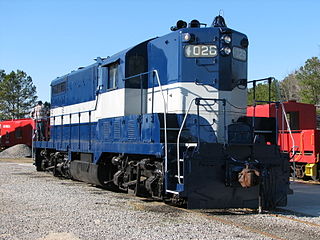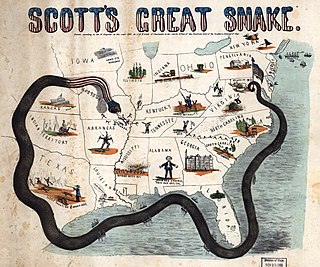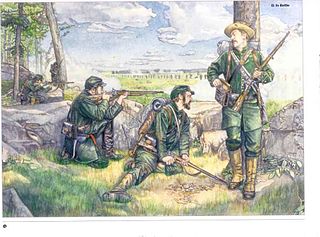
The United States Army Corps of Engineers (USACE) is the military engineering branch of the United States Army. A direct reporting unit (DRU), it has three primary mission areas: Engineer Regiment, military construction, and civil works. USACE has 37,000 civilian and military personnel, making it one of the world's largest public engineering, design, and construction management agencies. The USACE workforce is approximately 97% civilian, 3% active duty military. The civilian workforce is primarily located in the United States, Europe and in select Middle East office locations. Civilians do not function as active duty military and are not required to be in active war and combat zones, however volunteer opportunities do exist for civilians to do so.

The Confederate States Marine Corps (CSMC), also referred to as the Confederate States Marines, was a branch of the Confederate Navy during the American Civil War. It was established by an act of the Provisional Congress of the Confederate States on March 16, 1861. The Corps' manpower was initially authorized at 46 officers and 944 enlisted men, and was increased on September 24, 1862, to 1,026 enlisted men. The organization of the Corps began at Montgomery, Alabama, and was completed at Richmond, Virginia, when the capital of the Confederate States was moved to that location. The headquarters and main training facilities remained in Richmond throughout the war, located at Camp Beall on Drewry's Bluff and at the Gosport Shipyard in Portsmouth, Virginia. The last Marine unit surrendered to the Union army on April 9, 1865, with the Confederacy itself capitulating a month later.

The Atlantic Coast Line Railroad was a United States Class I railroad formed in 1900, though predecessor railroads had used the ACL brand since 1871. In 1967, it merged with long-time rival Seaboard Air Line Railroad to form the Seaboard Coast Line Railroad. Much of the original ACL network has been part of CSX Transportation since 1986.

Hunter Army Airfield, located in Savannah, Georgia, United States, is a military airfield and subordinate installation to Fort Stewart located in Hinesville, Georgia.

The Georgia Railroad and Banking Company also seen as "GARR", was a historic railroad and banking company that operated in the U.S. state of Georgia. In 1967 it reported 833 million revenue-ton-miles of freight and 3 million passenger-miles; at the end of the year it operated 331 miles (533 km) of road and 510 miles (820 km) of track.

The Plant System, named after its owner, Henry B. Plant, was a system of railroads and steamboats in the U.S. South, taken over by the Atlantic Coast Line Railroad in 1902. The original line of the system was the Savannah, Florida and Western Railway, running across southern Georgia. The Plant Investment Company was formed in 1882 to lease and buy other railroads and expand the system. Other major lines incorporated into the system include the Savannah and Charleston Railroad and the Brunswick and Western Railroad.
CSSIsondiga was a wooden gunboat that served in the Confederate States Navy during the American Civil War. Designed according to Matthew Fontaine Maury's plan to produce a large number of small vessels to swamp the Union blockade, Isondiga was one of only two or three of these Maury gunboats actually completed, and the only one completed as designed. The Maury gunboats project had been almost entirely cancelled in favor of ironclad production after the Battle of Hampton Roads. Isondiga was built in Savannah, Georgia, and was transferred to the Confederate Navy in January 1863 to begin the fitting out process. At this time, she was commanded by Lieutenant Joel S. Kennard.

The Port of Savannah is a major U.S. seaport located at Savannah, Georgia. As of 2021, the port was the third busiest seaport in the United States. Its facilities for oceangoing vessels line both sides of the Savannah River and are approximately 18 miles (29 km) from the Atlantic Ocean. Operated by the Georgia Ports Authority (GPA), the Port of Savannah competes primarily with the Port of Charleston in Charleston, South Carolina to the northeast, and the Port of Jacksonville in Jacksonville, Florida to the south. The GPA operates one other Atlantic seaport in Georgia, the Port of Brunswick. The state also manages three interior ports linked to the Gulf of Mexico: Port Bainbridge, Port Columbus, and a facility at Cordele, Georgia linked by rail to the Port of Savannah. In the 1950s, the Port of Savannah was the only facility to see an increase in trade while the country experienced a decline in trade of 5%. It was chaired and led by engineer Dr. Blake Van Leer.

The Siege of Fort Pulaski concluded with the Battle of Fort Pulaski fought April 10–11, 1862, during the American Civil War. Union forces on Tybee Island and naval operations conducted a 112-day siege, then captured the Confederate-held Fort Pulaski after a 30-hour bombardment. The siege and battle are important for innovative use of rifled guns which made existing coastal defenses obsolete. The Union initiated large-scale amphibious operations under fire.

The lower seaboard theater of the American Civil War encompassed major military and naval operations that occurred near the coastal areas of the Southeastern United States: in Alabama, Florida, Louisiana, Mississippi, South Carolina, Texas, Port Hudson, Louisiana, and points south of it.
The Southeastern Greyhound Lines, a highway-coach carrier, was a Greyhound regional operating company, based in Lexington, Kentucky, USA, from 1931 until 1960, when it became merged with the Atlantic Greyhound Lines, a neighboring operating company, thereby forming the Southern Division of The Greyhound Corporation, called also the Southern Greyhound Lines.

The Piedmont Atlantic megaregion is a neologism created by the Regional Plan Association for an area of the Southeastern United States that contains parts of the states of Alabama, Georgia, Tennessee, South Carolina, and North Carolina. The region includes the Atlanta, Birmingham, Charlotte, Memphis, Nashville, Research Triangle (Raleigh–Durham), Upstate South Carolina (Greenville–Spartanburg–Anderson), and Greensboro–Winston-Salem–High Point metropolitan areas. The megaregion generally follows the Interstate 85/20 corridor. According to Georgia Tech, the Piedmont Atlantic represents over 12 percent of the total United States population and covers over 243,000 square miles (630,000 km2) of land.
Ram Air Freight was a cargo airline based in Morrisville, North Carolina, United States. It specialized in prompt freight transportation. The airline had its main base at the Raleigh-Durham International Airport. It ceased operations on March 2, 2012.
Jacksonville Air Route Traffic Control Center (ZJX), (radio communications, Jacksonville Center) is one of 22 Area Control Centers in the United States. It is located at 37075 Aviation Ln, Hilliard, Florida.

The 1st Georgia Sharpshooter Battalion was a sharpshooter unit of the Confederate States Army during the American Civil War. It was authorized by an act in April 1862 by the Confederate Congress, and was formed in Savannah, Georgia. The 1st Battalion Sharpshooters served at Fort McAllister defending the coast of Georgia in the Battle of Fort McAllister (1863). They also saw action at the Battle of Jackson, Mississippi, as well as the Battle of Chickamauga, and the Chattanooga Campaign. The battalion fought to the end of the war, their last engagement being at the Battle of Bentonville in March 1865.

From April 4–5, 2022, a mesoscale convective system and numerous discrete supercells produced a swath of severe weather and several tornadoes in the Southeastern United States, including several strong, long tracked tornadoes. An EF3 tornado damaged or destroyed several homes in Bonaire, Georgia while a large EF3 tornado prompted a tornado emergency for Allendale and Sycamore, South Carolina. A violent EF4 tornado in Black Creek, Georgia resulted in one fatality as it destroyed several neighborhoods, and another large EF3 tornado caused widespread heavy tree damage northeast of Ulmer, South Carolina. More severe storms occurred across a large portion of the Southeast ahead of a cold front on April 6–7, with more tornadoes reported in South and Central Georgia and further south into Florida, all of which were weak. Along with the one tornadic death, trees felled by straight-line winds killed one person each in Louisiana and Texas.

The CSX A Line forms the backbone of the historic Atlantic Coast Line Railroad Main Line, the backbone of their network in the southeastern United States. The main line runs from Richmond, Virginia to Port Tampa just southwest of Tampa, Florida, a distance of nearly 900 miles. Along its route it passes through Petersburg, Rocky Mount, Florence, Charleston, Savannah, Jacksonville, and Orlando. With the exception of a short 61-mile segment in Greater Orlando, the entire line is owned by CSX Transportation.













